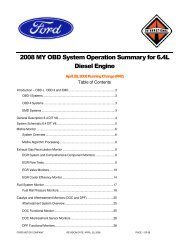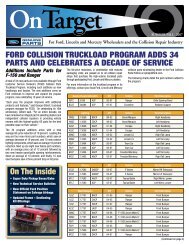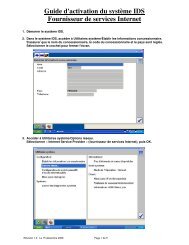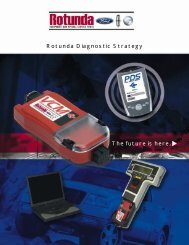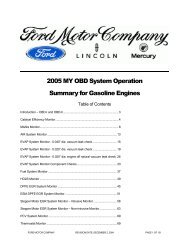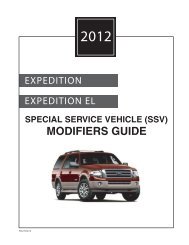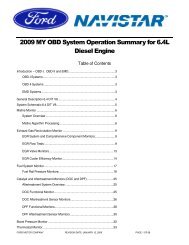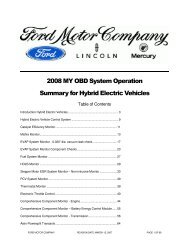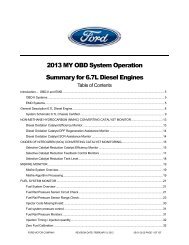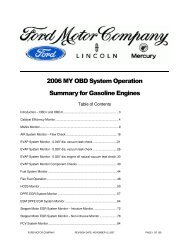2005 MY OBD System Operation Summary for Gasoline Engines
2005 MY OBD System Operation Summary for Gasoline Engines
2005 MY OBD System Operation Summary for Gasoline Engines
You also want an ePaper? Increase the reach of your titles
YUMPU automatically turns print PDFs into web optimized ePapers that Google loves.
$%$> );" #;!The 5R55S replaces the 5R55W transmission from 2002 <strong>MY</strong>. The diagnostics <strong>for</strong> the 5R55S and 5R55W areidentical. The controls are slightly different <strong>for</strong> vehicles that use Electronic Throttle Control (ETC) versus vehiclesthat do not use ETC.;The Digital Transmission Range (DTR) sensor provides a single analog and three digital inputs to the PCM. ThePCM decodes these inputs to determine the driver-selected gear position. This input device is checked <strong>for</strong> opensand invalid input patterns. (P0708, P0705)Turbine Shaft Speed (TSS) and Output Shaft Speed (OSS) sensors are analog inputs that are checked <strong>for</strong>rationality. If the engine rpm is above the torque converter stall speed and engine load is high, it can be inferredthat the vehicle must be moving. If there is insufficient output from the TSS sensor, a malfunction is indicated(P0715). If there is insufficient output from the OSS sensor, a malfunction is indicated (P0720).;Shift SolenoidsThe Shift Solenoid (SSA, SSB, SSC, SSD) output circuits are checked <strong>for</strong> opens and shorts by the PCM bymonitoring the status of a feedback circuit from the output driver (P0750 SSA, P0755 SSB, P0760 SSC, P0765SSD).These vehicle applications will utilize an inductive signature circuit to monitor the shift solenoids functionally. TheISIG circuit monitors the current signature of the shift solenoid as the solenoid is commanded on. A solenoid thatfunctions properly will show a characteristic decrease in current as the solenoid starts to move. If the solenoid ismalfunctioning, the current will not change (P1714 SSA, P1715 SSB, P1716 SSC, P1717 SSD). The ISIG testruns in conjunction with the other transmission functional tests. The lack of communication between the ISIG chipand the PCM microprocessor is also monitored (P1636).Electronic Pressure Control OutputsThe VFS solenoids are variable <strong>for</strong>ce solenoids that control line pressure and gear selection in the transmission.The VFS solenoids have a feedback circuit in the PCM that monitors VFS current. If the current indicates a short toground (low pressure), engine torque may be reduced to prevent damage to the transmission. (P1747, P1789,P0797).The VFS solenoids are also checked <strong>for</strong> functionality by utilizing a rationality test that looks at gear ratios. IfVFS/shift solenoid electrical faults and shift solenoid ISIG faults are not present, then actual ratios versus expectedratios are used to infer VFS failures. (P0745 PCA, P0775 PCB, P0795 PCC)Torque Converter ClutchThe Torque Converter Clutch (TCC) output circuit is a duty-cycled output that is checked electrically <strong>for</strong> opens andshorts by the PCM by monitoring the status of a feedback circuit from the output driver (P0743).These vehicle applications will utilize an inductive signature circuit to monitor the torque converter clutch. The ISIGcircuit monitors the current signature of the TCC solenoid as the solenoid is commanded on. A solenoid thatfunctions properly will show a characteristic decrease in current as the solenoid starts to move. If the solenoid ismalfunctioning, the current will not change (P1740). The ISIG test runs in conjunction with the other transmissionfunctional tests. The lack of communication between the ISIG chip and the PCM microprocessor is also monitored(P1636).FORD MOTOR COMPANY REVISION DATE: APRIL 28, 2004 PAGE 111 OF 131



